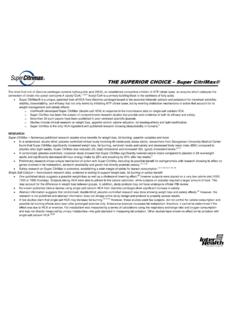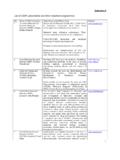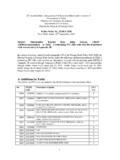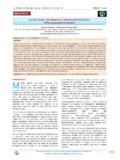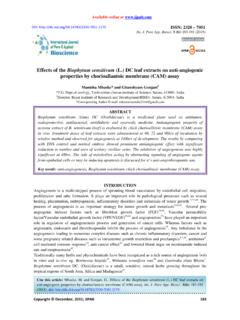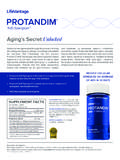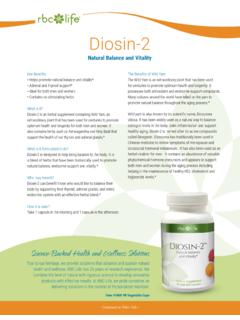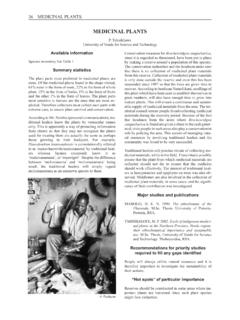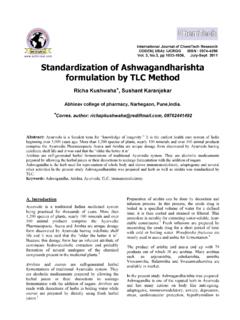Transcription of A Standardized Withania Somnifera Extract …
1 50 ORIGINALRESEARCHA Standardized Withania SomniferaExtractSignificantly reduces Stress-RelatedParameters in Chronically Stressed Humans: A Double-Blind, Randomized, Placebo-Controlled StudyBiswajit Auddy, PhD1*; Jayaram Hazra, PhD2; Achintya Mitra, MD2; Bruce Abedon, PhD3; Shibnath Ghosal, PhD11. Research and Development Center, Natreon Inc., Salt Lake City, Kolkata, India 2. Central Research Institute (Ayurveda), Ministry of Health and Family Welfare, Govt. of India, Bidhan Nagar, Kolkata, India3. Director of Scientific Affairs, NutraGenesis LLC, Brattleboro, VermontABSTRACTW ithania Somnifera (WS) has historically been used inAsia for treating stress-related health conditions. In thisstudy, we investigated the effects of Standardized WS rootand leaf Extract (WSE) in chronically stressed humans in amodern clinical trial. Participants were randomly assignedto WSE (125 mg QD, 125 mg BID, or 250 mg BID) orplacebo groups. Stress levels were assessed at Days 0, 30,and 60 using a modified Hamilton anxiety (mHAM-A)scale.
2 Biochemical and clinical variables were measured atDays 0 and 60. Of 130 subjects enrolled, 98 completed thestudy. Between Days 0 and 60, the WSE 125 mg QD groupdecreased signif icantly more than placebo for meanmHAM-A score, serum cortisol, serum C-reactive protein,pulse rate and blood pressure, and increased significantlyfor mean serum DHEAS and hemoglobin. Other WSE treat-ment groups had greater dose-dependent responses in theseparameters and had significantly greater responses com-pared to placebo in mean fasting blood glucose, serum lipidprofiles and cardiac risk ratios. Participants and dropoutsreported no adverse effects. Therefore, this study providesevidence that the consumption of WSE significantlyreduces experiential and biochemical indicators of stresswithout adverse words: Withania Somnifera , antistress, withanolides,sitoindosides, cortisol, C-reactive is a major component of modern life, causingadverse physiological conditions such as cognitive deficien-cies, impaired glucose and lipid homeostasis, immunosup-pression, sexual dysfunction, gastric ulceration, and alter-ation in serum cortisol and dehydroepiandrosterone sulfate(DHEAS) of active management andtreatment protocols that control stress-related symptomswith minimum adverse effects would be of great Somnifera Dunal (Solanacea) (WS) has tradi-tionally been used in Asia for safely managing and treatingstress.
3 Also known as Ashwagandha, Indian ginseng andwinter cherry, it belongs to a rasayana(vitalizer) group ofmedicinal plants that stabilize and revitalize systemic func-tions. The Ayurvedic system of medicine claims that it pro-motes stress relief, health and longevity by potentiating theimmune system,arresting premature aging, restoringhomeostasis and increasing resistance to adverse environ-* Correspondence:Biswajit Auddy, PhDResearch and Development Center, Natreon 18A, Sector IISalt Lake City, Kolkata 700 091, IndiaE-Mail: Vol. 11, No. 1, 2008 JANA Vol. 11, No. 1, 2008 51mental factors, collectively known as the antistress-adapto-genic , its healing effects on chronicallystressed individuals have never been evaluated in a random-ized, controlled clinical bio-actives, including withanolide glycosides(also known as sitoindosides) and withanolide aglycones,are considered to be responsible for the medicinal proper-ties of ,6 Traditional medicinal use of WS hasemployed root powder derived from wild plants,7which arerelatively low in concentration of varieties differ morphologically from wild WS,8andhave higher levels of bioactive ,9 Methods tofurther concentrate levels of bioactives in Standardized WSextracts (WSE)
4 Have also been The objective of this study was to investigate, in chron-ically stressed adults, the impact of WSE on experientialand biochemical indicators of stress and anxiety as well ascardiovascular risk, and to evaluate WSE AND METHODS This double-blind, randomized, placebo-controlled studywas conducted from November 2004 to October 2006 at theCentral Research Institute (Ayurveda), Ministry of Healthand Family Welfare, Bidhan Nagar, Kolkata, India (CRI), inaccordance with the World Health Organization's Guidelinefor Good Clinical Practice and the World MedicalAssociation Declaration of , 11 The CRI EthicsCommittee approved the protocol. Patients identified asstressed in the CRI outpatient department were assessed clin-ically (blood pressure, resting heart rate, reflexes, and neuro-logical and psychological status) and completed a question-naire assessing the severity of stress symptoms (cognitive,mood and behavioral) based on a Bengali version of a modi-fied Hamilton anxiety (mHAM-A) scale for , 13In the questionnaire, patients rated symptoms of anxi-ety (fatigue, flushing, perspiration, loss of appetite,headache and muscle pain, feelings of impending doom,palpitations, dry mouth, sleeplessness, forgetfulness, irri-tability and inability to concentrate) on a 5-point scale (0 =no symptoms; 1 = occasional; 2 = mild/poor; 3 = moderate;4 = severe).
5 The total score was calculated by adding thescore from individual questions. Men and women aged 18 to 60 years were eligible forthe study if they had a mHAM-A score of 24 to criteria were any concomitant serious physicaldisorder(s) or antistress treatment (antidepressants, anxi-olytic) that was ongoing or had occurred during the previ-ous month. Exercise as well as drugs that lower serumlipids, blood pressure or blood sugar were not consideredexclusion criteria, but this was not considered a significantbias in the study because only two participants ( of thetotal) were taking drugs of this nature (hypertensive) andthey were allocated randomly into different treatmentgroups. Participants provided written informed consent inEnglish and Bengali, the local language, and were random-ly divided into four groups using a computer-generated ran-dom number list: WSE 125 mg QD, WSE 125 mg BID,WSE 250 mg BID, and WSE used in this study {trade names Sensoril (Natreon Inc.)}
6 , New Brunswick, New Jersey) and Essentra (NutraGenesis, LLC, Brattleboro, Vermont)} was derivedfrom a withaferin A and corresponding withanolide glyco-side-predominant, genetically uniform chemotype, whichwas cultivated in the central and northern provinces ofIndia. WS root and leaf material was processed using awater-based extraction protocol and assessed using highperformance thin layer chromatography analysis of frac-tions against standard references (CAMAG Linomat Vapplicator, CAMAG TLC Scanner, and WinCats softwareversion ; CAMAG, Sonnenmattstr. Muttenz,Switzerland) in accordance with US Patent 6,713,092. Thesingle lot of WSE used in the study had a composition withanolide glycosides, withaferin A, oligosaccharides, alkaloids, and with no scopolamine, pyrrolizidine alka-loids or aristolochic (125 mg or 250 mg) plus excipients or excipientsonly (placebo) were placed in coded hard-gelatin capsulesidentical in size, shape, color (opaque white) and received two bottles of capsules and were toldto take one capsule from Bottle 1 before lunch and one cap-sule from Bottle 2 before dinner for 60 days.
7 Participants inthe WSE 125 mg QD group took a 125 mg WSE capsulebefore lunch and a placebo capsule before in the other groups took two of the same cap-sule (corresponding to the group name, , the placebogroup took two placebo capsules, etc.) each day. At each offour visits, participants received a 15-day supply of cap-sules. Compliance was monitored by counting the remain-ing pills at each follow-up visit and at the end of the about tolerance ( , treatment-emergentadverse effects) was obtained by questioning the partici-pants and clinically examining them at each visit. Experiential feelings of stress and anxiety wereassessed by calculating the sum of scores from the mHAM-A questionnaire taken at baseline (Day 0), Day 30 and Day60. To measure biochemical markers of stress and anxiety,participants fasted overnight prior to visits at baseline andDay 60 to avoid diurnal variations (particularly in serumcortisol concentration14).
8 Blood samples (6 10 mL) werecollected in vacutainer tubes (BD Vacutainer SystemsMedical Supplies, Plymouth Devon, UK) between 9 11 , stored at 4 C, and assayed for serum concen-trations of cortisol, dehydroepiandrosterone sulfate(DHEAS), C-reactive protein (CRP), fasting blood glucose(FBG), total cholesterol (TC), triglycerides (TG), low-den-sity lipoprotein cholesterol (LDL-C), very low-densitylipoprotein cholesterol (VLDL-C), high-density lipoproteincholesterol (HDL-C), and hemoglobin at a laboratory(Doyen Diagnostic & Research Foundation, 59 BhupenBose Avenue, Kolkata-700004) accredited by the NationalAccreditation Board for Testing and CalibrationLaboratories, Dept. of Science and Technology,Government of India. Pulse rate and blood pressure werealso scores were calculated by subtracting sumvalues at 30 days from baseline, 60 days from baseline, and60 days from 30 days for each variable individually and forthe total anxiety score.
9 Difference scores were then com-pared among groups using 1-way analyses of variance withpost hoc pairwise comparisons of the three treatmentgroups with the placebo group using the least significantdifference method. Percent changes were expressed as thedifference between the means of the baseline and treatmentphases divided by the mean of the baseline phase multipliedby 100. Cardiovascular risk ratios (TC:HDL-C and LDL-C:HDL-C) were calculated as TC divided by HDL-C andLDL-C divided by HDL-C, respectively. Values between 5 for TC:HDL-C and between and for LDL-C:HDL-C indicate average risk of developing coronaryartery disease and heart size calculationswere not done for this study. P< was considered sta-tistically of 160 eligible participants, 130 (95 men, 35women; mean age= years) initially enrolled in the study(Table 1) and 32 (26 men, 6 women) dropped out (WSE 125mg QD group, 11; WSE 125 mg BID group, 5; WSE 250 mgBID group, 1; and placebo group, 15).
10 Reasons for studywithdrawal were protocol violations, 6; being lost to follow-up, 10; physician s decision, 4; and lack of efficacy, 12. Thisdropout rate (and the fact that lack of efficacy was the largestcategory of dropouts) is fairly common in clinical trials ofpsychiatric drugs and is well within professionally recog-nized dropouts were not included in thefinal analysis, per-protocol analysis was followed and intent-to-treat analysis was not in all WSE treatment groups experiencedimproved well being at Day 30 and Day 60 (Figure 1). The125 mg QD group decreased significantly (P< ) inmean sum mHAM-A score from baseline ( ) to Day 30( ; ) and to Day 60 ( ; ) compared tothe placebo group, which showed no significant meanchange in sum mHAM-A score throughout the study. Meansum mHAM-A scores for the other WSE groups decreasedeven further than for the 125 mg QD group in a dose-dependent manner. The mean sum mHAM-A score for theplacebo group at baseline, , was lower than those of theWSE-treated groups (which ranged between ), butnot significantly.

